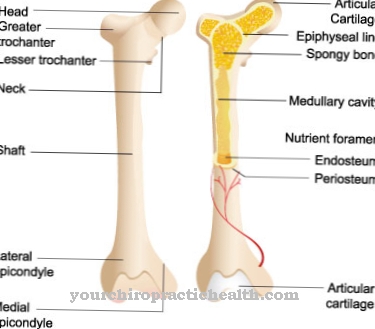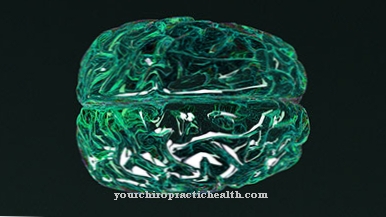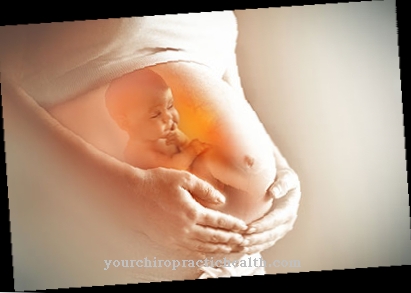Many women know one Intermenstrual bleedingthat occur regardless of menstruation during the female cycle. Intermenstrual bleeding can be harmless as well as an expression of worse illnesses. Intermenstrual bleeding should therefore always be clarified by a doctor.
What is intermenstrual bleeding?
Under one Intermenstrual bleeding is understood as an additional bleeding that occurs independently of the female menstruation in the course of the cycle. This is a bleeding disorder that can manifest itself in light spotting with light or brownish blood.
However, intermenstrual bleeding can last for several days and be very severe. Intermenstrual bleeding should be taken seriously as it can have very different - sometimes not harmless - causes. Therefore, intermenstrual bleeding should always be clarified by the attending physician, ideally a gynecologist.
In the event of sudden, very heavy bleeding, which may also be associated with pain, the patient should immediately consult a doctor or the nearest hospital, as such intermenstrual bleeding can be an acute emergency.
causes
The causes of a Intermenstrual bleeding are diverse. They can be harmless if, for example, it is ovulation bleeding or contact bleeding after intercourse. Intermenstrual bleeding is often hormonally related, such as a lack of luteal hormones, menstrual disorders or when taking hormonal contraceptives.
Hormonal disorders of the female cycle are particularly common at the onset of sexual maturity (puberty) or before the menopause. In connection with an (early) pregnancy, intermenstrual bleeding can also occur if the fertilized egg is implanted in the uterine lining or if there is an ectopic pregnancy. Mental or psychological problems also favor intermenstrual bleeding.
However, diseases of the genital organs such as uterine or fallopian tube infections, benign myomas or polyps, endometriosis or benign and malignant tumors are also possible triggers. Metabolic diseases such as thyroid dysfunction or diabetes and organ diseases such as liver and kidney disorders must also be clarified by the doctor as the cause of intermenstrual bleeding.
Symptoms, ailments & signs
Intermenstrual bleeding can be accompanied by the classic menstrual symptoms such as pelvic pain or breast tenderness. It is characteristic of occurrence outside of the normal menstrual cycle. There is often spotting shortly before your period, which can be recognized by a brownish color and is caused by hormones. Intermenstrual bleeding is also possible in the middle of the cycle.
This is often lighter and can indicate ovulation. The implantation bleeding of a fertilized egg also belongs to the category of intermenstrual bleeding. Inconsistent use of hormonal contraceptives can also trigger intermenstrual bleeding in women. The same applies to a contraceptive that is too weakly dosed. The intermenstrual bleeding can be a one-off event, but it can also occur regularly in the cycle.
However, not every intermenstrual period is caused by hormones. Intercourse outside of the cycle can also lead to intermenstrual bleeding. This is also referred to as contact bleeding, which can also occur after a gynecological examination.
It is often a symptom of intermenstrual bleeding that it is significantly weaker than the normal period. It also often does not last that long and can be over again after two days. Often, physical exertion or strong pressure when using the toilet triggers the intermenstrual bleeding, which then often disappears again quickly.
Diagnosis & course
At a Intermenstrual bleeding the patient should always ask her gynecologist for advice. By interviewing the woman, he will first find out the accompanying circumstances such as pain, fever, duration and severity of the bleeding and then select the examination method based on his suspected diagnosis.
Through a palpation examination and the microscopic examination of the vaginal secretion smear, he receives initial indications of any pelvic inflammation that may be present. A blood test will give the doctor clues about inflammation, hormonal problems, or metabolic disorders. With the help of an ultrasound examination, the gynecologist can clarify whether changes such as tumors, myomas or polyps can be seen in the abdomen.
If necessary, further diagnostics are necessary for clarification: Various surgical interventions such as a uterus or laparoscopy are available to diagnose the intermenstrual bleeding. The course of intermenstrual bleeding depends on the cause and can be harmless or serious, depending on the situation.
Complications
Intermenstrual bleeding is usually not a problem. Complications can arise if the bleeding is particularly heavy or if the bleeding continues for an excessive amount of time. This can lead to anemia and deficiency symptoms, and the risk of a serious underlying disease also increases. Even light bleeding can indicate a serious condition in the female reproductive organs, such as cervical cancer or fallopian tube inflammation, which, if left untreated, can lead to serious complications.
If an intermenstrual bleeding is caused by fibroids in the uterus, swelling of the legs, lower back pain, constipation and other sequelae that require independent treatment can occur. Sometimes a bleeding outside of the norm also indicates a hormonal imbalance - emotional complaints and physical changes can be associated with it.
Infections are also occasionally expressed in the form of intermenstrual bleeding and, if left untreated, can develop into severe inflammation in the area of the uterus and cervix.In pregnant women, intermenstrual bleeding can indicate a so-called rupture of the placenta. The placenta becomes detached from the wall of the uterus and causes life-threatening complications for women and children. To rule out these and other complications, intermenstrual bleeding should definitely be clarified by a gynecologist.
When should you go to the doctor?
A one-time slight intermenstrual bleeding can indicate the presence of an emotional stress state. If the challenges are overcome in everyday life and no further abnormalities occur, a doctor does not need to be consulted. When young girls menstruate, there is often no cause for concern either. Harmonizing the menstrual cycle at the beginning and at the end of the sexually mature period often takes a few months before everything goes smoothly. During this time, natural irregularities occur that have no further disease value.
If the symptoms persist for several months or if the bleeding increases in intensity, a doctor is needed. Regular intermenstrual bleeding should be discussed with a doctor as it can indicate an illness. If there are other complaints such as abdominal pain, abnormal odor or general malaise, a doctor's visit is also necessary. If the intermenstrual bleeding occurs after an intense sexual experience, this is also rarely a cause for concern. The techniques should be checked and optimized so that there are no further disruptions. If help is needed, a doctor can be consulted.
Pregnant women should always consult a doctor immediately if they have intermenstrual bleeding. The bleeding can indicate possible complications during pregnancy and should therefore be clarified as soon as possible.
Treatment & Therapy
Treating a Intermenstrual bleeding always adjusted to the cause. The gynecologist advises his patient about the possible options. If the cause is ovulation or contact bleeding, no further treatment is usually necessary. If there is a hormonal or thyroid problem, the gynecologist will seek drug therapy (hormone replacement therapy or thyroid hormone therapy) to alleviate the symptoms.
In the case of hormonal problems, therapy with the contraceptive pill may also be an option if there is currently no desire to have children. In the case of intermenstrual bleeding during pregnancy, hormonal therapy as well as physical rest and high-dose magnesium administration are used.
If fibroids, endometriosis, polyps or tumors are the cause of the intermenstrual bleeding, an operation can be considered in addition to hormonal therapy. The primary goal in the surgical removal of the growths is always the preservation of the genital organs, especially if the woman still wants to have children. If the patient has cancer, the usual cancer therapy such as surgical removal of the tumor, chemotherapy and radiation is available.
If it is a metabolic disease such as diabetes or organic problems such as liver or kidney problems, the gynecologist may refer the patient to a specialist for further treatment of the diseases underlying the intermenstrual bleeding.
You can find your medication here
➔ Medicines for menstrual crampsprevention
To one Intermenstrual bleeding To prevent this, a healthy lifestyle is recommended. Women should therefore avoid being overweight, not smoke, eat healthily and do a lot of sport. Regular examinations at the gynecologist help detect changes in the abdomen at an early stage and initiate appropriate therapy. Pregnant women who tend to bleed between periods should take care of themselves and avoid stress.
Aftercare
Intermenstrual bleeding is a normal phenomenon that affects many women. In most cases these are completely harmless. A medical examination is usually not necessary. However, if the intermenstrual bleeding occurs repeatedly or very heavily, a visit to a gynecologist is recommended. The doctor can clarify the cause of the intermenstrual bleeding and initiate suitable countermeasures.
Often there are hormonal changes that can be treated with medication. Follow-up care focuses on finally treating the symptoms and providing the patient with further support. Depending on the cause of the intermenstrual bleeding, other specialists can be contacted after the initial treatment.
Possible contact persons are internists, gastroenterologists or sex therapists. The gynecologist usually takes care of intermenstrual bleeding. A final physical examination usually takes place as part of the aftercare.
In addition, there is a patient interview so that the doctor can clarify any open questions. Depending on the cause of the complaints, the anamnesis can also take place during a consultation. After the follow-up care, the normal gynecologist appointments should be resumed. If the complaints reappear, the gynecologist must be informed.
You can do that yourself
In the event of recurrent intermenstrual bleeding, the gynecologist should be consulted. If the doctor rules out an organic cause, various home remedies can be used to regulate the cycle. Various medicinal plants and agents with hemostatic effects have proven themselves.
The shepherd's purse, for example, has a hemostatic effect and is ideal for heavy or prolonged bleeding. The plant is best taken in the form of a tea until the symptoms have subsided. Monk's pepper is rich in phytohormones, which support progesterone production in the body. It mainly helps with spotting and intermenstrual bleeding that occurs repeatedly. The medicinal plant can be taken in the form of capsules from the pharmacy or as a tea.
General measures such as rest and relaxation are also helpful. Affected women are best to take time off and cure themselves completely when the intermenstrual bleeding occurs. Plenty of water should be drunk and an appropriate diet should be observed. Warm pads help relieve pain and feelings of pressure, such as can occur with repeated bleeding. In addition, moderate exercise can be done. Light stretching or gymnastics exercises regulate the metabolism and release happiness hormones. If the symptoms do not go away with these measures, a visit to the gynecologist is recommended.



























